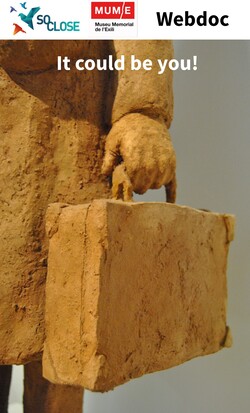The traumatic experience of the Civil War and exile has not only reached us through the photographic testimony of Robert Capa, Manuel Moros, Auguste Chauvin, Agustí Centelles or Francesc Boix, the Mauthausen photographer, to cite a few.
The numerous artists, intellectuals and politicians who swell the ranks of the 1939 exodus have left us important artistic, literary and scientific production.
In the field of the visual arts, many artists left accounts of their experiences. Antoni Clavé, Josep Franch-Clapers, Carles Fontserè, Nicomedes Gómez, Josep Bartolí, Josep Subirats, Manolo Valiente and José Lamuño are some of these creators. In MUME you can enjoy the vision of part of the work of Josep Franch i Clapés (Castellterçol,1915–Saint-Rémy, 2005) that shows life in the French concentration camps and in the groups of foreign workers.
Catalan literature was very prolific in these years of exile. Nabí by Josep Carner, the Corrandes d’exili by Joan Oliver “Pere Quart”, the Elegies de Bierville by Carles Riba, Els Fugitius and Els Vençuts by Xavier Benguerel and K.L. Reich by Joaquim Amat-Piniella are some of the works that can only be explained from the perspective of the exile of their authors. For them, literature was the oasis of freedom that their status as exiles did not allow them to feel. Through their mother tongue, they recovered the homeland that they had had to leave against their will and through writing they expressed feelings, anxieties and fears of everyday life.
Moreover, the direct testimony of the Civil War and exile of historians such as Ferran Soldevila, collected in the Dietaris de l’exili i el retorn, or Antoni Rovira i Virgili in Els darrers dies de la Catalunya Republicana, have become mandatory reference works for those interested in this historic period.
The written press was also very prolific from the outset in the French concentration camps. In addition to France, Mexico was also rich in publications in Catalan.
Within this periodical press, we can distinguish often more ephemeral publications, linked to political parties and trade unions, such as La Humanitat, Treball and Endavant. Other relevant periodical publications were Revista de Catalunya, El Poble Català, Quaderns de l’Exili and Revista dels catalans d’Amèrica.
In other host countries, the arrival of Republican exiles contributed to driving forward already existing publications created by Catalan emigrants in countries such as Chile and Argentina, as in the case of the journals Germanor and Ressorgiment.
In this room dedicated to the legacy of exile, in addition to artists and writers, there is also a place for politicians, resistance fighters and men of science, among others. This indicates that Republican exile also had an unquestionable qualitative relevance. The losses in human and scientific capital were enormous and in many ways irrecoverable. However, despite all these obstacles, great artistic and scientific careers began and developed in exile, which often benefited the host countries, especially Mexico and some other Latin American states.
As a closing of the exhibition space of this room dedicated to the legacy of exile, there is a small room reminiscent of several exiled Empordà, a space for contemporary photography (Alfred Mauve) relating to places of passage into exile. de l'Empordà and a showcase where testimonies and documentary legacies of exile are collected, where, alternatively, donations and assignments of the protagonists of the republican exile are shown from a more individualized and personal perspective in the showcase that we call it "Biographies of Exiles."




